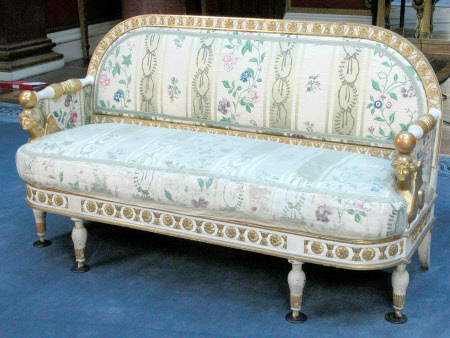Sofa
Carlo Randoni (1755-1831)
Category
Furniture
Date
circa 1820 - 1827
Materials
Pine, walnut, paint, gilding, painted silk
Measurements
94 x 163.5 x 67 cm
Place of origin
Genoa
Order this imageCollection
Attingham Park, Shropshire
NT 608166.4
Summary
A sofa, of gilded, carved and painted pine and walnut, after a design of circa 1820-1 by Carlo Randoni (1755-1831), and made circa 1820-7 for Palazzo Tursi, Genoa. Covered in Italian painted silk. Part of a set of twenty pieces of seat furniture, the remainder probably designed by Carlo Randoni (1755-1831), comprising another sofa (NT 608166.5), five standard chairs (NT 608166.1.1-1.5) two open armchairs (NT 608166.2.1 & 2.2) and eleven stools (NT 608166.3.1-3.11). Covered in a variety of different silks. Havinga curved toprail, decorated with alternating rosettes and bound bundles of leaves. The arms turned as opposing balusteres with reeded collars and each terminating in a ball and raised on a gilded sphinx. The seat rails decorated with panels of alternating rosettes and bound bundles of leaves. Raised to the front on four legs turned as rising balusters with reeded collars, and to the rear on four tapering rectangular-section legs.
Full description
The design for this sofa was drawn by the architect and designer Carlo Randoni (1755-1831) in 1820-1. When the drawing was published in 2012, the author assumed that the sofa was lost, a view that has been corrected only recently following new research by National Trust furniture curators. The design shows a volute (scroll) at either end of the toprail, which was apparently omitted in the execution. The sofa is part of a set of twenty pieces of seat furniture which, in turn, is one of four sets of chairs, armchairs and stools of this type at Attingham (see also NT 608150, 608157 & 608168). The four sets are all in the Italian neoclassical style and are distinguishable only by the use of different motifs to decorate the toprails, seat rails and legs, and by their coverings, which are various and not consistent within sets. The matching of this sofa with Carlo Randoni's design strengthens the attribution to him of the other furniture in these sets at Attingham. In addition, many of the open armchairs, chairs and stools were signed or marked by the carvers and gilders who are known to have worked for Randoni during the refurbishment of Palazzo Tursi in Genoa in the 1820s. The sphinges which form the sofa's arm supports appeared in several of Randoni's designs for furniture at the Genoese Palazzo, such as the drawing for NT 608155, a side table. Palazzo Tursi, the residence of King Vittorio Emanuele I (1759-1824) and Queen Maria Teresa (1773-1832), was converted into a royal palace in 1819-21 and was modified again in 1824-27. An inventory of May 1822 listed ten sofas, twelve armchairs, 136 stools, eighteen 'x'-frame stools and thirty-eight chairs amongst the contents of the Palazzo. Maria Teresa (by then the Queen Dowager following Vittorio Emanuele's death in 1824) died in 1832 and, although no evidence of a sale, or a dispersal auction, has been found, it is believed that William Noel-Hill, 3rd Baron Berwick (1773-1842), acquired this furniture when returning home to England via Genoa in 1833. Throughout his time in Italy as a diplomat, William Noel-Hill had lived in close proximity to the Sardinian court, initially in exile at Cagliari (1808-14) and then Turin (1814-24), and after his diplomatic move to Naples (1824-33) he retained a house in Genoa. In 1842, when an inventory was taken at Attingham after his death, the bulk of the furniture was in storage in the Old Dining Room, but was subsequently used to furnish the house. Most of it remains in situ, and it is said to form probably 'the largest collection of its kind in the British Isles'. The pieces of furniture in the same set as this sofa are covered in six different types of silk. This sofa was apparently covered in Italian printed silk in the 1840s. Two armchairs decorated with the same rosettes and bound leaves are in the Palazzina dei Mulini, Portaferraio, Napoleon’s residence in exile on the Island of Elba and now a museum. In 1923, Edith Teresa Hulton, Lady Berwick (1890-1972) was painted, wearing a Mariano Fortuny cloak (NT 608972), in one of the set's armchairs by Gerald Kelly (1879-1972).
Provenance
3rd Lord Berwick collection: William Noel-Hill, 3rd Baron Berwick (1773-1842). Acquired by the 3rd Lord Berwick, who had been in Italy as British envoy and ambassador to the Kingdom of Naples and the Two Sicilies. By descent bequeathed to the National Trust with the estate, house and contents of Attingham by Thomas Henry Noel-Hill, 8th Baron Berwick (1877-1947) on 15th May 1953.
Makers and roles
Carlo Randoni (1755-1831), designer
References
Rowell & Burchard 2020: Christopher Rowell & Wolf Burchard, 'Italian Furniture at Attingham Park', Furniture History LVI (2020), 107-176, 123, 125-6, 145-7, 152-3, 173 fn. 179, 182-4 Figures 22-3, 41 & 43 Drury, 1984: Martin Drury. “Italian furniture in National Trust houses.” Furniture History, vol. XX, 1984., 38-44 Cornaglia 2012: Paoli Cornaglia, Giuseppe Battista Piacenza e Carlo Randoni: I Reali Palazzi fra Torino e Genova (1773-1831), Turin (2012), pp. 196-7 and fig. 5.31
